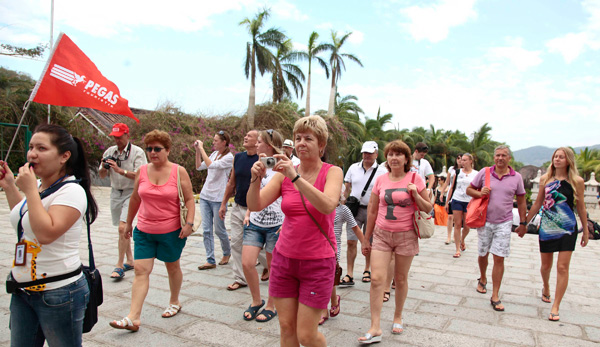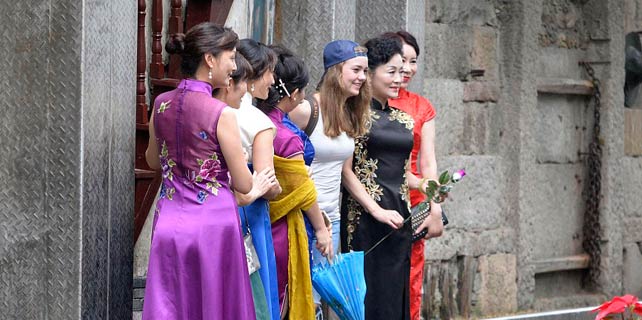China, the emerging medical tourism hot spot
 |
|
A group of Russian tourists visit the Nanshan Buddhism cultural resort in Sanya, Hainan province, in November 2012. CHEN WENWU / FOR CHINA DAILY |
Cups, needles, more
Acupuncture, cupping, tuina massage, and herbal medicine are some of the best-known TCM treatments overseas, but TCM master Professor Hu Kaiwen believes the ancient healing system has even more to offer.
Hu, president of Dongfang Hospital in downtown Beijing, is a veteran oncologist who specializes in integrating TCM with conventional Western medicine to treat advanced tumor patients.
While Western medicine sees cancer as abnormal cells to be annihilated, TCM considers the ailment a sign of imbalance of body and mind and prioritizes restoring balance rather than annihilation.
Hu said one Chinese philosophical saying applies: "Going beyond the limit is as bad as falling short."
His therapy combines minimally invasive surgery with post-surgery TCM care. It offers an alternative to patients who do not respond well to chemotherapy or radiation.
Hu said the herbs can work just as well to lengthen the lifespan and improve quality of life, but cost only a fraction of costly targeted Western drugs.
Wang Tiansong, president of the Sanya Hospital of Traditional Chinese Medicine, said foreign patients with cerebral palsy and strokes have also responded well to TCM treatment.
Last year, the Beijing University of Traditional Chinese Medicine set up a Chinese medicine center in St. Petersburg as an outpost.
"TCM is centered around being green and natural, making it compatible with Russians' passion for nature," said the center's Chinese director Wang Chaoyang.
Infra, promotion
Hainan is not the only tourism hot spot where foreign medical travelers swarm.
In China's northwestern Xinjiang Uygur autonomous region, the Russians are joined by Kazakhs and other Central Asians from across the border.
At the Sixth Affiliated Hospital of Xinjiang Medical University in Urumqi, signs are written in three languages-Chinese, Uygur and Russian. About 80 foreigners sought treatment in the first three months after the hospital opened its international department.
Wu Yue, a top hospital official, said the demand from across the border is so strong that the hospital plans to start building an Asian Orthopedic Center.
These developments have been incorporated into the Belt and Road Initiative the Chinese leadership proposed in 2013. Xinjiang has positioned itself as a regional hub that offers services to the region, including health care.
Meanwhile, Hainan, once a key stop on the ancient Maritime Silk Road, is already being marketed as an international tourist island.
Investors have now set their eyes on medical infrastructure.
A public-private partnership cancer hospital, which cost 2.9 billion yuan ($426 million), opened last year in Hainan's capital city of Haikou. Equipped with state-of-the-art facilities and 1,200 beds, the hospital mainly targets wealthy treatment seekers from outside the province.
China's State Administration of Traditional Chinese Medicine and the National Development and Reform Commission late last year set a target to build 10 TCM health tourism model zones offering medical treatment, wellness, recuperation, and elder care by 2020.
Woodman said China is on the path to establishing quality health care infrastructure. In 2007, there were only three Chinese medical centers accredited by the Joint Commission International, while today there are more than 77.
The next step, he said, will be to work toward promoting China as a medical tourism destination by working with the travel and economic development sectors.
Some have sensed the business opportunity.
Russian national Yana recently quit her tour guide job to join the Sanya Hospital of Traditional Chinese Medicine as a marketing officer.
Yana, who has been a tour guide in Sanya for 12 years, said her new job is promising.
"A lot of my Russian clients know about TCM and are interested in coming over," she said.
















